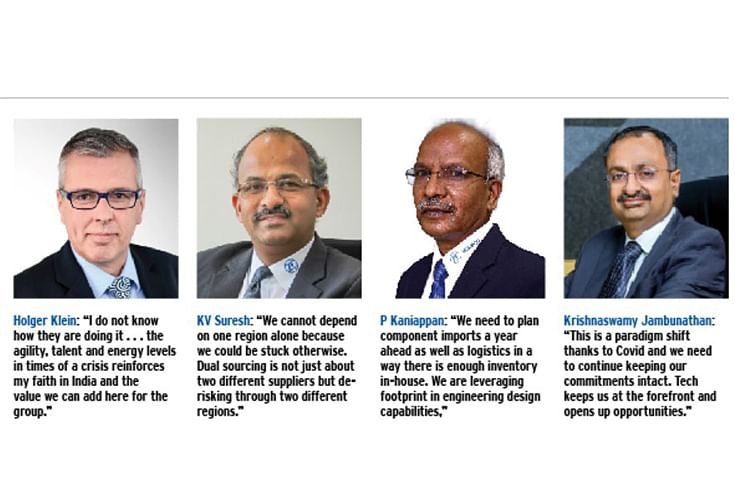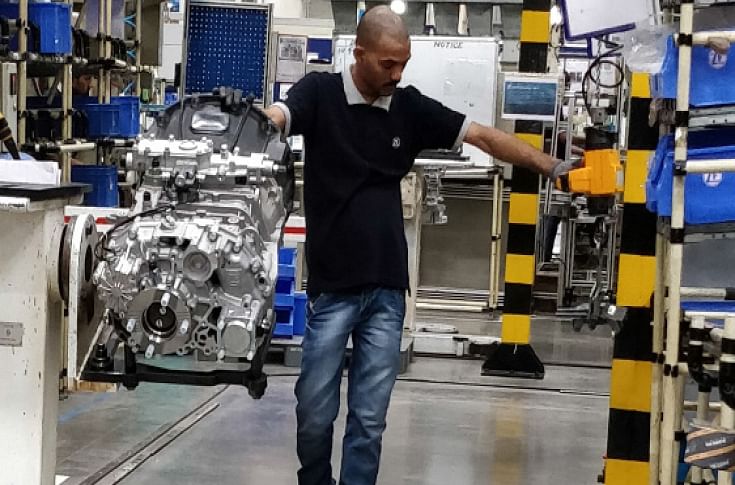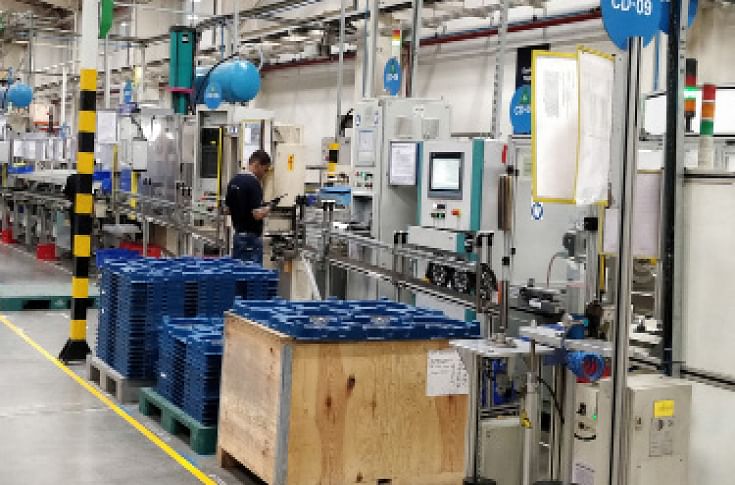ZF creates new global template for India
The German auto ancillary supplier recently announced its intent to invest 200 million euros in India as part of a new growth strategy which will gain traction with the acquisition of Wabco.
Holger Klein is absolutely categorical that localisation is key to the formulation of a de-risk strategy in these challenging times.
As member of the board responsible for the ZF business in Asia Pacific and India (where, along with the rest of the world, it is a supplier of driveline and chassis technology for cars and trucks) he insists that “we need to localise as much as we can and look for dual sourcing.”
Covid is but one example of a crisis that is still raging worldwide but there are a slew of natural disasters like earthquakes and floods which can also wreak havoc across factories. “It is important to have more resilient supply chains and this is where going more local is the way forward,” says Klein.
As he points out, there is more volatility to come beyond the pandemic and “I am not even talking about politics”, something that cannot be wished away either — what with growing tensions between the US and China and leadership positions being redefined worldwide.
Klein, who works out of Shanghai, is part of a video interview which includes KV Suresh, President ZF India, P Kaniappan, MD, Wabco India (which was recently inducted into the ZF fold globally), and Krishnaswamy Jambunathan, Head, ZF India Technology Centre, Hyderabad.

Whilst on the subject of de-risking, Suresh says the VUCA (volatility, uncertainty, complexity and ambiguity) factor remains very high in today’s times but there are other issues to ponder over too. “We always used to talk of capacity in the supply chain. In this case, there was capacity and manpower but we could not get the material,” he explains.
As Suresh puts it, both localisation and regionalisation become important in this background. “We cannot depend on one region alone because we could be stuck otherwise. Dual sourcing is not just about two different suppliers but de-risking through two different regions,” he says. Hence, if one were to fail, the other supports business continuity which, in turn, takes a different turn now with a few more parameters added “where an OEM and supply chain are concerned”.
In his turn, Kaniappan says recent events during Covid have only highlighted the importance of SIOP (sales, inventory and operations planning) more so now. “We need to plan component imports a year ahead as well as logistics in such a way that there is enough inventory in-house,” he adds.
Jambunathan narrates how the Hyderabad centre had only three weeks to shift the workforce when Covid spread its tentacles across the Indian landscape. A timely response from the engineering team was critical at this difficult juncture and they pulled it off. Klein is quick to acknowledge this effort where over 2,500 engineers from India had been serving the ZF world before the pandemic made its appearance.
The fact that they ensured that the show went on has clearly earned the Hyderabad team his admiration. “I do not know how they are doing it . . . the agility, talent and energy levels in times of a crisis reinforces my faith in India and the value we can add here for the group,” says a visibly pleased Klein.
No wonder then that he cites the example of Google and the fact that “there is something about Indian leadership” — it is a model that ZF is also keen to follow where it can create career paths for people in India. “Perhaps, we are a bit late but can still make up for lost time,” he adds.
Covid has also imparted other valuable lessons as Kaniappan explains. For instance, the focus at Wabco has shifted rapidly to digital which has become the norm today. Zero defect production is possible with digital tools which also play a role in creation of safe surroundings. “Youngsters are able to write programs cost-effectively,” says Kaniappan.
Suresh chips in to add that customer interactions can be done quickly thanks to digital interfaces and decisions can be taken fast too. The pandemic has also shown that fixed offices need not be the norm anymore. Klein agrees with this view while elaborating that “the way we work has changed and you can stay at home especially in Delhi, Mumbai, Chennai, Shanghai or New York where you spend endless hours on the road”.
The challenges were different for Jambunathan and his team at the Tech Centre where it was about moving the workforce and getting on with WFH (work-from-home). One key outcome was moving to the cloud which has helped reduce cycle time. “This is a paradigm shift thanks to Covid and we need to continue delivering and keeping our commitments intact. Technology keeps us at the forefront and opens up opportunities,” he says.

ZF is doubling down its focus in India through a significant investment of 200 million euros (Rs 1,653 crore) and strategic consolidation of its business domains with renewed impetus to drive growth over the next decade.
ZF recently announced its intent to invest 200 million euros in India, a market which Klein believes has the “potential to grow exponentially” with its strong fundamentals. “Technology and education are strong headwinds in India and we at ZF need to play our role,” he says.
While the group was “pretty fragmented” to begin with, the acquisition of TRW in 2015 was a game changer. Now with Wabco being the latest addition last year, it was critical to open new opportunities and hence the rebooted strategy for India.
The obvious strengths of the subcontinent lie in its “big and dynamic” market, strengths in sourcing and manufacturing, its potential as an engineering hub where the Hyderabad centre was set up two years and has 2,500 engineers already, and finally as a service hub for other shared services. “We are trying to develop these four (competencies) with Indian talent…at ZF we don't have enough Indian leaders yet globally,” he emphasises a point made earlier.
Hence, it was important to “put your money where your mouth is”. Ambition had to be backed by intent and hence explain the investments Wabco is now undertaking for expansion in commercial vehicles. Testing and validation is happening at Hyderabad and Pune while the focus on wind power in Coimbatore is equally important.

ZF's transmission plant in Pune. The Tier 1 major has a presence of over six decades in India and operates through its three subsidiaries and four joint venture partners.
“India is facing its toughest crisis — which is true for the world too — in terms of Covid but the answer is not to be scared and go back into your hole and wait. When we took over Wabco during the pandemic, it showed our commitment and our focus on India will only strengthen,” says Kelin. ZF will leverage this time to “get the basics right’ and then grow with the market as part of the anticipated V-shaped recovery.
Clearly, the country will play a bigger global role as Kaniappan explains. Over the last 10-12 years, Wabco was exporting 40 percent of its output and has now emerged as a centre of excellence for products like heavy duty compressors. These are supplied to Volvo trucks globally and shipped out of the Mahindra World City plant near Chennai.

ZF consistently relies on digitalisation to create new opportunities. It is investing in automated driving, electromobility, vehicle motion control and integrated safety.
“With the low cost supply chain in India for compressor manufacturing where we make 400,000 units translates into a scale advantage,” elaborates Kaniappan. New business is now coming in from Daimler which only shows how Wabco has walked the talk in raising the bar for India.
“Likewise, we are leveraging our footprint in engineering design capabilities,” he continues. The company has launched products like actuators globally with the cost advantage “we provide and support on building quality”.
This has helped access more markets in Europe and the US. “Exports are a key growth area and will expand for mechanical systems from here to other ZF entities. We will do everything to help our global parent from India,” says Kaniappan.
Beyond the frugal engineering mindset which is a huge bonus for exports, digital technology capabilities and platforms are being developed for connected vehicle technologies. “India has a strong talent pipeline in digital and software,” he adds.
Klein believes the recent buyouts have made ZF a commercial vehicle powerhouse of sorts for OEM customers especially when there are not too many suppliers with such a large portfolio ranging from AMT to e-axles. “You will see more and more global players discussing with us for future technologies and we see a sweet spot in India and globally for software etc,” he says. Going forward, ASEAN could be a big play especially when there are some interesting partnerships happening like Hino and Traton.
The Hyderabad Tech Centre will play a big role in this transition and Jambunathan says speed is what “we are focusing on” as evident in the rapid ramp up of the talent pool from zero to 2,000 plus in barely four years. The centre literally “touches every ZF region” from Hyderabad — it played a key role during the TRW and ZF coordination which was happening then.
“We were the pilot in showing how the integration could happen and have grown our competencies with this experience,” adds Jambunathan. The synergies have helped give value back to ZF globally. In his view, one also needs to move up the value chain as in the case of customers in the Asia Pacific region where the software responsibility comes out of India. Bringing technology and engineering together is what ZF believes will be its USP.
The company is also betting big on electric mobility and has partnered the Mahindra group on Formula E while “actively supporting them to get to the podium”. As Suresh says, “We need to show our capabilities in cutting edge technology of the present even while we have not forgotten technologies of the past which are also important for a market like India.”
These include transmissions, clutches and shock absorbers which “we excel in” while balancing this basket out with e-mobility and ADAS. This is where Hyderabad is a great enabler along with Wabco. Suresh says there are some key initiatives like FAME 2, and more recently the PLI scheme, which “require us to be on the sidelines — as someone who is present and capable of supporting OEMs with latest technologies”.
ZF is already in talks with its customers in cars and CVs on these technologies and working jointly “to support them at the right time”. The idea is to grow with the market as a technology player and “maintaining our leadership” in well known technologies as part of a dual strategy.
“We want to shape the mobility of the future which includes transport as a service. We will also stay focused on where we can make a difference…and for the rest to find the right partner. The time you think you can master it all is over and size is relative given the dynamics of the industry,” declares Klein.
This feature was first published in Autocar Professional's October 1 issue.
RELATED ARTICLES
Complete List of Cars and SUVs Tested by Bharat NCAP
Bharat NCAP has crash-tested 20 models to date, including both ICE-powered vehicles and EVs.
Belrise Industries: A Story of Grit and Focus
The Belrise Industries IPO is the culmination of a multi-decade journey by entrepreneur Shrikant Badve that started in a...
Mahindra and Lightweighting: Solid Steel To Nimble Aluminum
Stricter emission regulations and rising fuel efficiency targets are driving a fundamental transformation in powertrain ...





 01 Oct 2021
01 Oct 2021
 17078 Views
17078 Views





 Autocar India
Autocar India


 Shahkar Abidi
Shahkar Abidi


